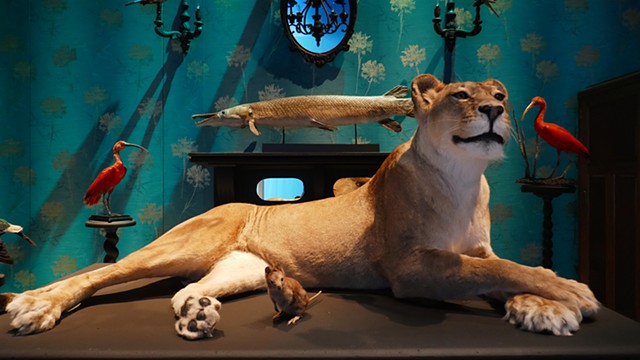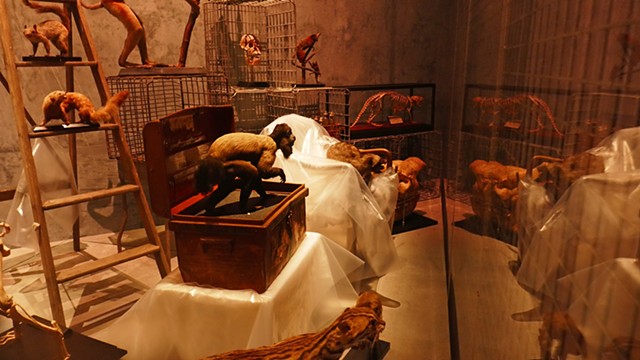The Art of Death 1 & 2
Art of Death Wild Places
Mansfield’s Menagerie by Karley Feaver
7 August – 31 October 2021 : Katherine Mansfield House
About my installation
Beneath Mansfield’s conventional use of anthropomorphism and natural landscapes as settings for the exploration of human concerns, there is an ecocentric ethos in her questioning of man and nature. Mansfield’s extrospective awareness of nature was her desire to connect with a menagerie of animals and other forms of nature through her writing. Her writings contain many references to animals, and she sees “the animals as co-actors moving and doing in their world, of which humans are a part”.
Mansfield was often exploring how nature influences her inner state, her ambivalent relationship with nature, how nature has the power to comfort the person interacting with it, yet it also has the power to unsettle. She had an astute awareness of the complexity of human-nature relationships and often blurs the boundaries between humans and nature.
To many people, nature is still often referred to as separate from human, humans are the superior and nature the inferior. In order to show how they are not strictly separated, but rather connected, my installation challenges the dualistic thinking about the natural world and how Mansfield captured this in her writings. I am bringing the outside in.
Birds, fawn and deer, but not as we know them, enter through the scullery door and make their way through the kitchen. Bringing with them flowers and leaves, branches, weeds and moss from the garden, these curious animals settle themselves in amongst the furniture. The animals are characters I have invented from the words of Mansfield’s stories, moving in their own world, of which the humans become a part of. Mansfield was often interested in showing how her characters responded to the sense of nature’s power, and she pays attention to the way the human mind engages with the natural environment.
Birds have taken on mutations of floral assemblage. Birds in flight with floral bouquet sprouting from their head, a dancing bird with weeds which have taken on the colours of the feathers, a sleeping rooster who has become overgrown with the foliage from a nearby shrub. The birds display their foliage proudly and there are others who have succumbed to the force of Mother Nature, taking their last moment in life resting on a bed of moss. The deer and his fawn companion gently and curiously walk inside, bringing with them moss, leaves and branches and resemble the part of the landscape where it’s a little wilder and unknown. I am constructing an immersive and visceral experience of nature that, just like Mansfield’s writing, blurs the boundaries between humans and nature. I am bringing the outside in.
........................................................................................................................
The Art of Death 1 - An Installation at Highwic
Objects of Loss and Remembrance by Karley Feaver
The Art of Death
The Metropolitan Club, in association with Hendrick’s Gin and Highwic, supported by Heritage NZ and the Auckland Museum, will explore in The Art of Death from the 14th September – 27th October 2019.
About my installation
Objects of loss and remembrance are private things filled with a personal and, at times, incommunicable significance. They celebrate death, beauty, nostalgia and a desire for longing.
A souvenir which belonged to a departed loved one is powerful, but a souvenir which once was a beloved is intoxicating. Objects are seducers and comforters, fragrant with memories and human longing and nostalgia. But nostalgia cannot exist without loss. And this loss is precisely the souvenir’s power: In taxidermy, the souvenir lives eternally and what was dead becomes lifelike. But to live eternally and to live again a thing must first be dead, and this is what taxidermy is. Death. The dead.
Our era loves to pride itself on being the most environmentally sensitive age, which is true in many respects, but how many of us can name more than one species of birds in our backyards. The nineteenth-century infatuation with natural history might have been destructive, but it wasn't a nebulous, abstract, or careless fancy. Victorians knew their nature and doted on specific species, whether dead or alive. And our fascination with taxidermy has enabled many intimate encounters with creatures that would not otherwise be possible.
Victorian taxidermy played a very different role within its socio-historical scenario from that played by the contemporary art revisionist movement. "They were a reminder of nice things in nature beyond the grimy cities," says Dr Pat Morris. The real decline took place in the 1950s and 1960s when it became less socially acceptable. There were other things to do with animals rather than shooting them, such as filming and photographing them.
Objects of loss and remembrance explores this enigmatic duality of Victorian taxidermy – both death and splendour, damage and desire. Reflecting on the Victorian and colonial roots of taxidermy and Museum dioramas and how taxidermy has in recent years catapulted in all directions within the contemporary art scene and transforming taxidermy into a rare and complex form of art.
........................................................................................................................
About The Art of Death
It’s the 21st century and taxidermy is fashionable once more.
Gone are the days where gentleman hunters were mounting the spoils of their morbid excursions, this Victorian art-form is currently experiencing a female-led resurgence that has a reverence for wildlife and conservation at its heart. It is this renewed interest in the art of taxidermy that The Metropolitan Club, in association with Hendrick’s Gin and Highwic, supported by Heritage NZ and the Auckland Museum, will explore in The Art of Death from the 14th August – 27th October 2019.
The Art of Death is a multi-disciplinary exhibition by seven female artists which will transform the rooms of historic gothic mansion Highwic, into curious new settings. Supported by a programme of experiential activations, the exhibition will explore the the curious life affirming possibilities found in death, interrogate the macabre and its spectrum of gothic aesthetics as well as examining attitudes toward death, mourning and commemoration through creative cultural and social practices from the Victorian era to today.
Beyond enjoying these specially created installations, visitors can go ‘beyond the ropes’ and get up close and personal by taking an introductory taxidermy class, trying their hand at life drawings’ mysterious dark twin ‘Death Drawing’ with renowned artist Paris Kirby, attend a Hendrick’s Gin tea cup cocktail party or absinthe tasting, meet the artists at an afternoon salon or get the kids involved in a garden bug hunting art workshop
The exhibition will take visitors from taxidermy of the past, with a display of historical pieces from the Auckland Museum’s collection not normally on public display including a jaguar, badger, wombat and bear, as well as items from Highwic’s own collection, to the present, with room installations by artists Antoinette Ratcliffe, Karley Feaver, Hayley Theyers, Sophie MacDonnell, Jane Thorne, Paola King-Borrero and Kate Rampling. The Art of Death exhibition hopes that the experience of taxidermy and other death related art forms, combined with multi-sensory events and experiences, will encourage us all to live fully by exploring our own ideas of mortality.
This thoroughly modern take on this historical art-form will run from the 14th September – 27th October, at Highwic. Entry to the exhibition is $10 which goes towards the preservation and upkeep of this important Heritage NZ property.
Highwic is located at 40 Gillies Ave, Epsom, Auckland 1023 and is open Wednesday to Sunday 10.30am – 4.30pm.

























